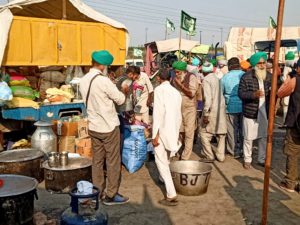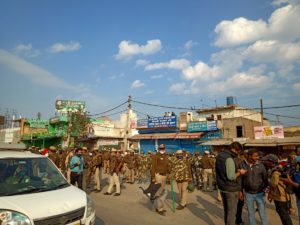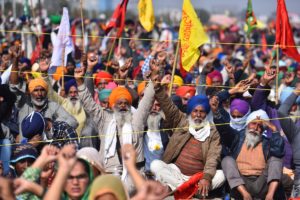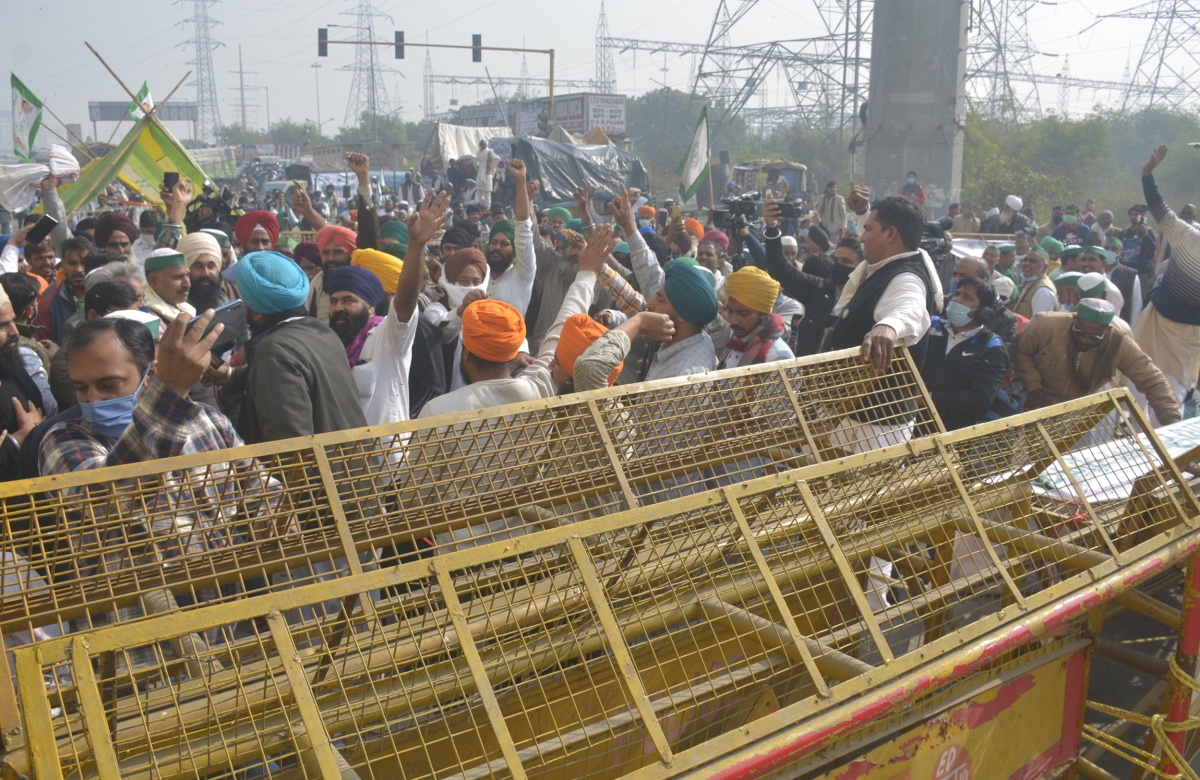The visuals of barricaded roads, water cannons, tear gas and online debates show Delhi under siege but behind the scenes, talks are going on that seem likely to lead to an impasse
Farmers’ protests against three bills — The Farmers (Empowerment and Protection) Agreement on Price Assurance and Farm Services Act, 2020 (FAPAFS), the Farmers Produce Trade and Commerce (Promotion and Facilitation) Act, 2020 (FPTC) and the Essential Commodities (Amendment) Act, 2020 (EC) — have snowballed into a colossal movement in the last three months. Now they are ready to smash through barricades on the borders of Delhi where security personnel have been deployed in heavy numbers to stop their march to Lutyens Delhi.
The initial reasoning behind denying farmers permission to march to Delhi was the spike in Covid-19 cases in the already ravaged Capital, which was observing around 7,000 -8,000 new cases per day until last week.
The farmers, though, didn’t find the interjection convincing, as they claim their livelihood is already at stake because of the new farm bills proposed by the Centre, “Then what will Corona do?” asks one protester.
To stop the protestors from reaching Delhi, then, the police deployed on the borders of the city blocked roads and used water cannons and tear gas.
On 26 November, the government backtracked from its initial decision and gave the farmers permission to use Burari as their protest site. The farmers, though, claimed that this was a ploy and said that it feels like an open jail. “This is an open air jail created in Burari, they are not going to listen to us, rather amass us all here and enclose the area to restrict our movement,” says Jagband Singh, a farmer protesting at Burari.
Hence, only a handful of farmers were observed at Nirankari Samagam ground in North Delhi, just a few miles away from the Delhi University campus. As such, for most part, protestors opted to remain at the borders of Delhi, namely Tikri and Singhu. All the while, farmers back in Haryana, Punjab, Western UP and Rajasthan are reportedly gearing to bolster up the numbers to increase pressure on the government.
Now as many as 35 farmer unions are protesting in Delhi, camping at various Delhi borders. They say, they will not leave until the government takes back the laws. Poetry sessions, concerts are being organised, as artists and athletes are joining farmers on a daily basis. On 7 December, several athletes said they are returning their awards. Led by two-time Asian Games gold-winning former wrestler Kartar Singh, a few sportspersons from Punjab and Haryana marched towards the Rashtrapati Bhavan to return “35 national sports awards” to show solidarity with farmers but were stopped by police.

A cursory look at the protest site shows inventiveness at full play. A library has been started by a few students who have joined the protest. They are also planning to conduct plays for the protesters. Various NGOs and student organisations have also made graffiti about the ongoing issue. Farmers are getting help from nearby villages. “People are generous here, they are supplying milk, wheat flour. Langars are non-stop, from food to basic necessities like blankets, everything is available here,” said Surjeet, a farmer.
Farmers are taking turns to keep protest bustling. A batch of farmers join, and others go back to their respective villages. However, thousands of them are planning to stay till the protest ends. The human lines stretch is as long as 15-20 km at Singhu border. Similar scenes can be seen at Tikri border.
The government has assured a dialogue, but the Union Home Minister’s call to protesting farmers to clear the border and join others in Burari if they wish to prepone the conversations, did not work. The move was outrightly rejected by farmers as they feel that this is a ploy.
Talks on 2, 3 and 5 December didn’t fetch any result, as farmers stated that they will not bend until their demands are met. On 8 December, farmers gave a call for Bharat Bandh,- a nationwide shutdown.
“We have asked the rest of our people to stay at the Delhi border and fight over there, we will take care of things here,” says Jagbandh Singh. With no change in the situation, the government has now declared that it will not make any prior demands before the talks. Farmers on their part want just one outcome and are ardent that no other option will work except for repealing the law or giving certain guarantees to safeguard their economical sustenance, as they fear that the government will stop the direct purchase of crops like wheat and rice at MSP which in turn would lead to the “corporatisation of farming.”
The government for its part is saying that the new laws would allow farmers to sell their produce anywhere in the country, and it will help them engage with private companies. The central government has also asked farmers to talk about their apprehensions and note down their reservation over these bills.
On 2 December, the farmers also showed concern over the Air Quality Management in the National Capital Region and Adjoining Areas Ordinance, 2020, which was issued after a plea was filed in the SC over the issue of stubble burning. They say that the ordinance may end up imposing unscrupulous fines in cases of stubble burning.
The battleground
Since the agitation against CAA-NRC, this is the biggest protest the National Capital has witnessed, however, despite massive support from different classes there are some bizarre trends doing the rounds.
First, the initial response by the Delhi Police to prevent farmers from entering Delhi over the rise of Covid-19 cases across the nation, that may exacerbate the situation. The same thought resonated in the media and then in the masses, as several people ignored the farmers’ cause prior to accusing them of becoming super-spreaders of the virus.

Second, the adversaries of the farm bills protest in the Capital have once again complained about the roadblocks and disruption of daily life. In October, the Supreme Court said that protesters cannot occupy public places indefinitely. And since CAA- NRC, the democratic right of protest at public places has been questioned several times, over public inconveniences like traffic snarls. However, farmers have pleaded that for the sake of their livelihood, they will try to manage their protest despite the hindrances, as they are agitating for the greater good. Otherwise, the government would not pay heed to their concerns.
Apart from this, the whispers of Khalistan infiltrators were also broadcast extensively on different mediums of communication, which further vilified the protestors on the border. Unfortunately, these claims were being levelled by verified Twitter handles of prominent personalities like actress Kangana Ranaut and director Vivek Agnihotri, among others. Farmers reflecting on the accusations of separatist tendencies claimed that they are false and responded that they are just farmers and not terrorists. “They are giving us the tag of being terrorists. We are not, we are just farmers, we are not here to divide this nation, we are here for our rights.” says Singh.
This battle is being fought on two fronts: at one place, the farmers are resisting the moves of the establishment, the initial sole agenda, while at the same time, the de facto spokespersons are legitimising their stance in front of the nation through a series of alleged defamatory reporting.
Several sympathisers of farmers’ protest are also taking on those demonising the protest on Twitter. Celebrities from Sonu Sood, Priyanka Chopra to writer Ravindra Singh showed support for the protesting farmers. Diljit Dosanjh, actor and singer, turned into a hero overnight due to his rebuttal of Kangana Ranaut’s comment on Twitter.
The farmers for their part, have now taken a bold stand and are boycotting the media houses they feel are serving the vested interests of the government and not reporting objectively. At Singhu border, farmers were seen chasing away reporters from media organisations, which they claim are, “misreporting” calling them “godi media”.
This message of not allowing certain media organisations to report does reinforce the support from the sympthasires of farmers, but how long will it be successful, it is yet to be seen.
The unrest and politics
Pratap Bhanu Mehta, an academician wrote in his latest article, that if the government successfully promulgates these important bills without much consultation with farmers, that it will be a “death knell” for farmers as a pressure group. This is somewhat of an existential question for them. Therefore, many farmers are joining the protests.
Interestingly, even allies from NDA’s ruling coalition are breaking rank to support the farmers. Hanuman Beniwal of Rashtriya Loktantrik Party (RLP), which is an ally of NDA, showed support for the movement. Earlier Harsimrat Kaur Badal resigned from the Union Cabinet over farmer’s unrest.
Many experts, however, are viewing these protests as the protest of rich farmers from Punjab and Haryana, who get a larger benefit from MSP on wheat and rice, who fear losing the benefits, coupled with larger nationwide agricultural distress adding fuel to these protests. To challenge these assertions, voices of protest from Maharashtra, Andhra Pradesh, Madhya Pradesh, and Telangana are also being raised.

Not just that, the protest has also engendered debates over the merits of these bills among academic circles. Economists like Ashok Gulati are seeing them as major reforms saying that these laws will open up options for farmers, all the while helping the government to improve management.
While the likes of Christophe Jaffrelot disagree. They think State support is necessary for the agriculture sector. “Without some support from the State, the smallest of Indian peasants would be even more vulnerable. According to provisional numbers from the 10th Agriculture Census 2015–2016, in India, ‘smallholder and marginal farmers’ (those with less than two hectares of land) account for 86.2 % of all cultivators — that is, almost 126 million people. For them, it is inconceivable to carry their produce to other states or far-off places to sell,” Jaffrelot wrote in his article for Indian Express.
Now, when talks are on, farmers and the government are trying to find a way out of the impasse. Reports suggest thousands more are coming to Delhi and will be joining the protesters. It seems the non- political nature of the protest and the fact that protestors are seen to occupy moral high ground, with India being essentially an agrarian country, the protest is the biggest challenge that the Modi government has ever faced.
(Cover: AT LOGGERHEADS: After days of protests, the Central Government is keen to talk to farmers to bring an end to the impasse PHOTO: Getty Images )





